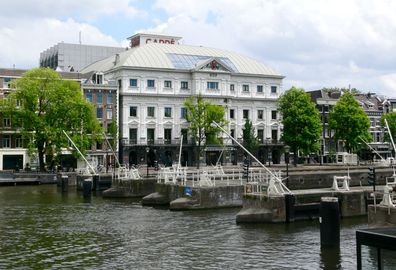

The Royal Theater Carre is another majestic building reposing along the banks of the Amstel river. The theater's name refers to the family of circus performers named Carré, who came to the Netherlands to perform in the early 1860s. In 1866 Oscar Carré received the permission to build his first stone theater and on December 3rd 1887 this building was officially inaugurated. It was immensely popular with Amsterdammers right from the start. In the first decades the theater was only used in the winter; and while the troupe travelled and performed abroad the rest of the year the building stood empty. However from 1893 onward the theater started being rented in the summers and the building was now in use the entire year. Carré had soon turned form a circus into a variety theater.
After Oscar Carré's death in 1911, the theater experienced a period of decline. No profits were made and several new directors came and went trying unsuccessfully to resuscitate the theater. Max Gabriël reconstructed the theater, but this didn't bring about any tangible results, so he left a year later. Boekholt announced a new program and new amusements, but this didn't work out either. Another business company tried to revive the circus but soon went bankrupt. At last in 1924 two gentlemen named Benjamin and Content had some success in bringing the theater back to life. Alex Wunnink followed Benjamin and Content as the director. He was also successful as director and the shows he brought turned out very profitable.
During the second world war Carré attracted many people, since the city residents were looking for a distraction. But after the searches in 1944, visitors shied away and Carré's was closed from 1944 until 1945. After reopening, the theater again struggled. Following Alex Wunnik’s death, his son Karel became the new director. Under him it experienced such serious problems that in 1968 Carré was sold with the intention of being demolished. A luxurious hotel was to be built in its place, however the municipality of Amsterdam intervened and devised a new plan. Two years later the building received 'monument status' and in 1974 GuusOsters became the new director. Initially he had a hard time attracting the public, but eventually a couple of new and very successful shows saved him and Carré face. In 1977 the city purchased the theater and after its one hundred year anniversary the theater was renamed the Royal Theater Carré.
This magical performance venue has been at the spotlight of the Dutch theatre world for the past 125 years. Actors, singers, circus acrobats, musicals and cabaret stars all ambitiously strive for a chance to perform at the Carré. Its numerous visitors speak of its lavish and magical ambiance. On summer nights, visitors can enjoy a magnificent view of the Amstel from atop the theater's neoclassical balcony with a glass of champagne in their hand. The first class local and international acts leave the visitors speechless with awe. Among recent performances were such diverse names as Tom Waits, the Dutch magician Hans Klok and the North Korean State Circus